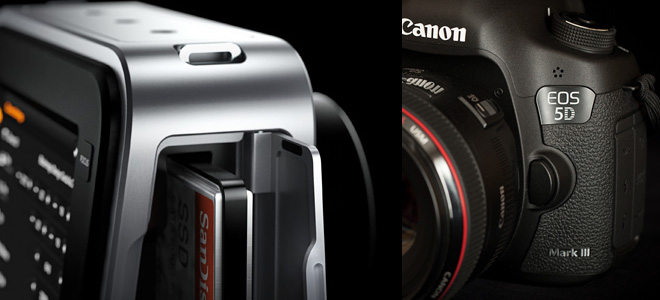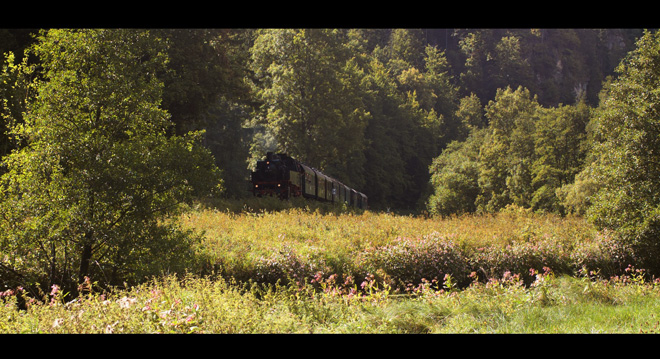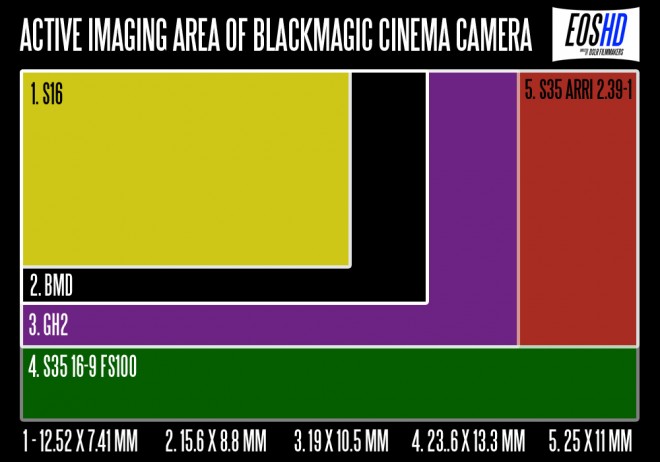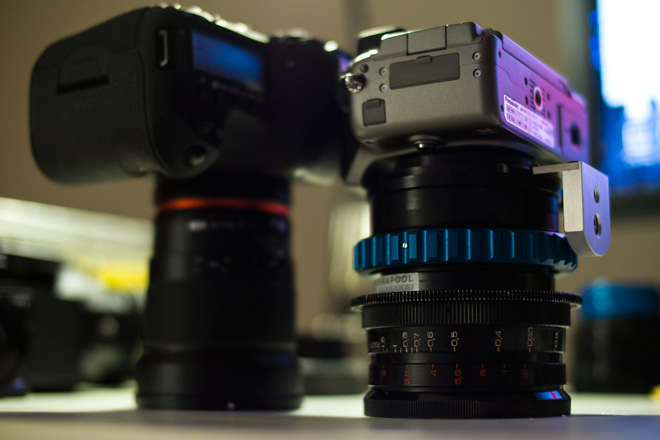
Check out the Blackmagic Cinema Camera versus 5D Mark III footage and blog post at EOSHD here
With both cameras around the $3000 with a Canon lens mount, and the DSLR being such a popular choice for video, I thought I’d examine the reasons for buying one or the other. Which should you choose?
The Blackmagic Cinema Camera is, I think, very healthy for the DSLR community. What it does is destroy the myth that a full frame sensor matters more than good overall image quality, and it introduces many to the benefits of a raw codec for the first time at $3000.
A raw codec effectively allows you to set your exposure, white balance and picture profile afterwards as well as giving us film grain rather than noise and 2.5K resolution rather than 600 lines of a supposed 1080p.
When you look at what you lose by choosing the 5D Mark III over the Blackmagic Cinema Camera versus what you gain, it is clear the food chain has been altered drastically at this price point.
What you gain by choosing the 5D Mark III:
- Stills
- Wide angle faster than F2.8
- Full frame rendering of your lenses
- Usable ISO 12,800
What you gain by choosing the Blackmagic:
- Raw codec
- Double the resolution (1000+ lines vs 600 lines)
- 13 stop dynamic range
- 12 bit colour
- 4-2-2 sampling
- HD-SDI
- Robust 1/4 audio jacks
- Da Vinci Resolve (it comes in the box)
- Significantly larger screen and easier focussing
- Peaking and one touch focus assist
- ProRes recording option
I admit that ISO 12,800 and the allure of that full frame look are fantastic features on the 5D Mark III. However I have my FS100 for low light and I’ve never been able to get as nice a video out of the 5D Mark II or III as I have from a crop sensor. I’ve examined the reasons why and it comes down to a lot of different things added together.
Still frame from the Blackmagic Cinema Camera in Bavaria with Seb Wiegaertner (via Facebook)
Why I shoot better with a crop sensor
Every advantage that a large sensor has is nulled in video mode on the 5D Mark III apart from one – the rendering of lenses, wide angles especially.
However I shoot a lot of my stuff further back from the subject with a long portrait lens or even a fast telephoto, so the full frame sensor hasn’t helped me here.
Let’s look at the advantage of a full frame sensor – and why you won’t see them when you hit record on the 5D Mark III:
- Resolution
Larger physical chip area allows you to fit more pixels on without reducing the size of the pixels. Unfortunately the data readout on the sensor in video mode crudely throws most of the 22MP data away for technical reasons - Dynamic range
Larger photosite wells allow for greater latitude and dynamic range, unfortunately the codec on the 5D Mark III renders shadows with a lot of macro-blocking and renders highlights with a steep clipping to white. Additionally the scaling down of the sensor with so much missing data throws away a lot of dynamic range – not as much as the resolution loss but significantly over 4 stops - Low light performance
Larger pixels make for low noise and scaling 22MP down to 2MP for video will always significantly hide a lot of noise at the per pixel level. Unfortunately the 5D Mark III is so challenged for detail in normal circumstances that in low light even more detail is smeared away and the image drops to just above standard definition quality
So the Blackmagic with its raw codec or Prores recording has far more dynamic range than the 5D Mark III. The 2.5K sensor does not scale in raw mode so pretty much the full resolution is available in the files – over 1000 lines compared to approximately 600 on the 5D Mark III. The lower megapixel count of roughly 3MP on the Blackmagic compensates for the smaller sensor and older pixel design, and although the camera cannot extend into the ultra high sensitive ranges at ISO 3200 and above that the 5D Mark III is capable of, it is rare that you need that kind of high ISO performance on a professional job.
Shallow depth of field
So the only remaining advantage on the 5D Mark III is how the large sensor renders your lenses. A shallow depth of field is available to isolate subjects further away from the camera and even at wide angle. The Blackmagic can do a shallow depth of field but it isn’t as pervasive.
On the Blackmagic Cinema Camera I consider a shallow depth of field to be 35mm F2 with your subject within 2m to the camera.
On the 5D Mark II you can get more than twice as wide a field of view and maintain that shallow depth of field. Go to a 50mm and your subject can be much further away from the camera and still isolated from the background.
This is undeniably a nice look and gives you more control over how much or how little depth of field you want, as long as you’re prepared to stop down the lens significantly to get it less shallow. This has a knock on affect on significantly lowering the low light performance of the camera because you often need to stop down to F5.6 to get the kind of manageable focus you’d get at F2.8 on the Blackmagic Cinema Camera.
The Hollywood standard of Super 35mm is a ‘crop sensor’ compared to the 5D Mark III. It makes more sense to compare the size of the Blackmagic Cinema Camera’s sensor to the Hollywood standard instead.
As you can see it is certainly closer to Super 16mm than Super 35mm, but the GH2 like I say – I rarely have issues with the sensor size in that (shown in purple above) compared to the FS100 (in green).
To get a 28mm wide angle on the Blackmagic requires a 12mm lens and on the GH2 to get 28mm requires a 15mm lens. On Super 35mm you need an 18mm lens. Lenses faster than F2.8 in all of these focal lengths are in short supply so it is not as if the BMD camera has a particular disadvantage here, though the demand for the Tokina 11-16mm F2.8 is likely to rocket. I can’t think of a better a wide angle for the EF mount than that.
Handling
The Blackmagic requires an external 12v power supply whilst the 5D Mark III just requires you to carry more spare batteries. However the power supply for the Blackmagic camera can be something as discrete as a slim base plate that sits under the camera, so it isn’t really an issue – just an additional purchase.
The 5D Mark III has a hand grip, but anyone who shoots handheld video using this is an idiot because it just looks dreadful. You need a rig for both if you are doing a handheld shoot. Otherwise, for barebones tripod usage the Blackmagic camera has an advantage because the screen is angled upwards and is much larger and more comfortable to see.
The 5D Mark III has more physical controls so you can adjust ISO and shutter speed in the middle of a shot. However I never do this!
The shutter speed should be 180 degrees and NDs used to get the right exposure. The ISO is irrelevant on a raw camera but you will need to set it approximately in extreme lighting, for example ISO 1600 in the dark not 200 so you can actually see what is going on.
Aside from these differences, they are merely picture making boxes so the handling comes down purely to how you rig them up. Aperture and focus is on the lens on both of course, unless you are using an EF lens with no aperture ring. Here the 5D Mark III has a more direct physical control to change the aperture on a Canon lens, on the Blackmagic it is done by physical buttons rather than a dial.
1/4 audio jacks and HD-SDI is very welcome and the camera is extremely robust.
Conclusion
I strongly believe the 5D’s days of being a pro video camera are behind it.
It doesn’t help that the Sony FS100’s used price is now approaching what the 5D Mark III costs new.
Looking forwards there’s trouble coming from Sony who will release a full frame video camera soon. With the Metabones adapter you can use your existing Canon glass on this. Likewise the Blackmagic Cinema Camera does not have to necessitate a reinvestment in lenses, just a Tokina 11-16mm F2.8 to cover the wide end.
Canon had a good run with the 5D Mark III but now what they need is a C100 for around $4000. Though I have never felt at a disadvantage with the 1.86x crop sensor on a GH2 over the FS100’s 1.5x, I am sure a Super 35mm C100 will look better to many people on paper than a 2.3x crop Blackmagic if the image quality and price is pretty equal.
Whilst the competition can easily exceed the sensor size of the Blackmagic Cinema Camera they will however have a hard time beating the image.





